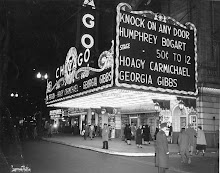She plays Sara Scott, one of those movie journalists who remains gainfully employed despite never
letting work get in the way of their personal life. She swans around wartime London in a fur coat, perfectly coiffed and oblivious to the realities of modern warfare although, to be fair, it's not difficult for her not to notice when director Lewis Allen has chosen to mostly omit it from the mise-en-scene. Other than a sequence showing sappers defusing an unexploded V2 rocket, and Scott's hired help making a passing reference to rationing, there's no indication that this is a city that's been at war for nearly 6 years. There's no bombed out buildings, no indication of food, gas or clothing shortages, and barely anyone in uniform on the streets.
As a peroxide blonde society lady who spends her time lunching, loving and shopping on 5th Avenue, Turner is entirely convincing. As a highly rated journalist ready to fly off at a moment's notice to whichever battle front her editor deems her presence and writing talents to be essential, she's somewhat less plausible than Steven Seagal tackling Shakespeare.
 Which brings us to Mr Connery's eyebrows. They are both a wonder and a mystery and put Robert Pattinson's brow hair to shame. His are wider but inexpressive and just sit there above his eyes. Connery's, in contrast, are longer and undulate like two strips of dark brown deep shag carpeting strapped to the back of a couple of adult earthworms. They're so impressive they actually distract attention from his luxuriant head of hair which to anyone used to the older, more follically challenged Connery, is a talking point in itself.
Which brings us to Mr Connery's eyebrows. They are both a wonder and a mystery and put Robert Pattinson's brow hair to shame. His are wider but inexpressive and just sit there above his eyes. Connery's, in contrast, are longer and undulate like two strips of dark brown deep shag carpeting strapped to the back of a couple of adult earthworms. They're so impressive they actually distract attention from his luxuriant head of hair which to anyone used to the older, more follically challenged Connery, is a talking point in itself.ANOTHER TIME ANOTHER PLACE was not the 28 year old's first movie but it was the first time his name had been billed in such close proximity to the film's stars, and clearly no one had considered that a little personal grooming might be in order to reflect his new status as love interest to a bona fide Hollywood star. His agent might also have found a tactful way to suggest that having Connery's character, with his distinct Scottish accent, wax lyrical at great length about his idyllic home town on the coast of Cornwall, might not be the most convincing.
But even shifting location and pruning his eyebrows would not have prevented this turgid drama from dissolving into a pool of smelly sludge. Nothing about it rings true and no one does anything to evince our interest or sympathy. It's just a bust.






